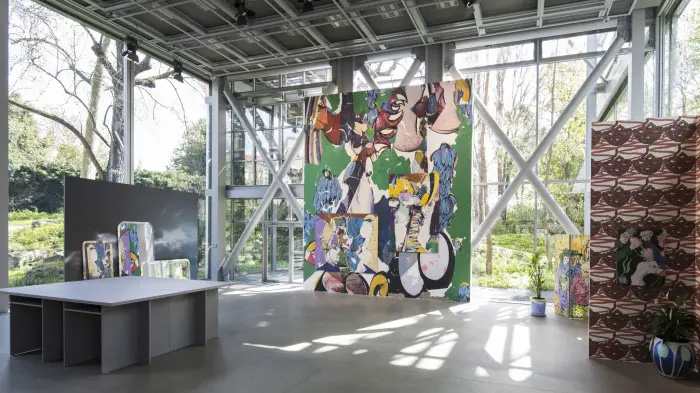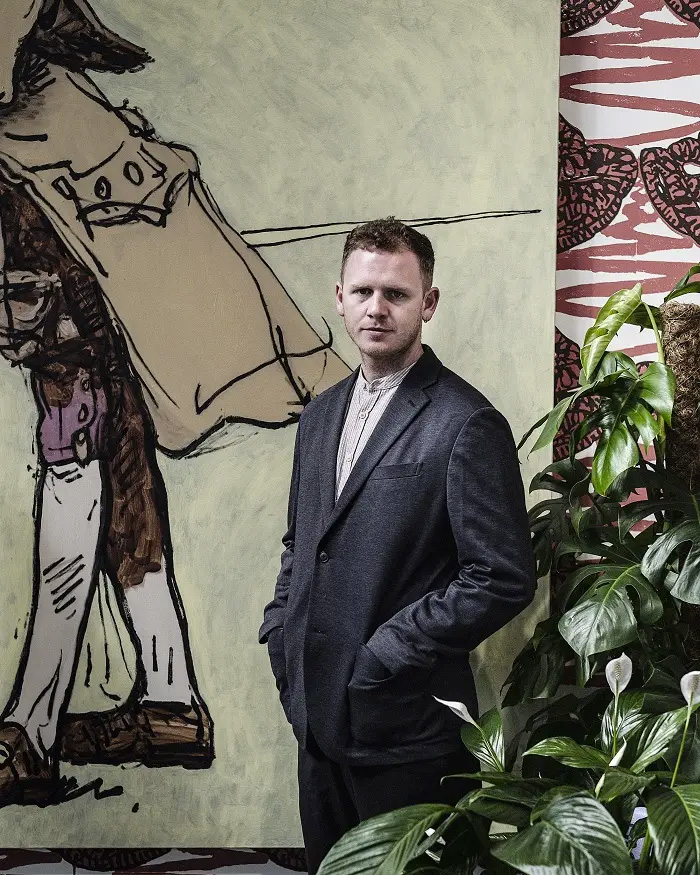
- Source: FINANCIAL TIMES
- Author: RACHEL SPENCE
- Date: APRIL 12, 2019
- Format: DIGITAL
At the Fondation Cartier, a generation of artists shaped by European crises comes of age
A Paris show of groundbreaking work from across the continent tells stories of brutal division but exudes a sense of optimism

With a cast of sinking people, abandoned rowing boats, derelict houses, makeshift furniture, human figures salvaged from scraps of clothing and abstract sculptures assembled from empty life-jackets, a new show of young European artists in Paris appears to pile up reasons not to be cheerful for the future of the continent.
In truth, glimmers of light are threaded through the gloom. Metamorphosis: Art in Europe Now at the Fondation Cartier centre for contemporary art in Paris brings together 21 artists from 16 European nations, including countries beyond the Union, born since 1980. This is a generation stamped by the tumultuous changes wrought by the collapse of the Berlin Wall, the war in the former Yugoslavia and the waves of migration that have transformed the continent’s social landscape.
The first note of joy is sounded by the building itself. Designed by Jean Nouvel in 1994, it has a glass-and-steel frame that is an airy foil to the tree-dotted garden that surrounds it and the luxuriant wall of plants designed by French botanist Patrick Blanc. The ferny flourish of the latter rescues from morbidity the soundtrack that greets visitors before they enter the building. Devised by Magnus Andersen, who was born in Denmark but lives in Brussels, the song is part of his series “Regional Education”. Chanted by children in different languages, it is a collage of extracts from European treaties, free trade agreements and national anthems. The marriage of their reedy voices and the repetitious rhythm conveys that this is a bittersweet welcome from a vulnerable, fractured people.
So it proves. In the two ground-floor galleries, a group of large-scale works have been made, we are told, “in close relation with the building around them”. Certainly the glass walls, which give an unfettered view of the garden beyond, create a porous realm that is a soothing alternative to the stories of brutal division narrated by the art within. Nevertheless, in the way it has been curated the overall installation feels a little cramped. Such serious-minded and physically imposing works require room to breathe.

The most affecting works leaven the sadness with visual allure. Born and based in Stockholm but with Chinese heritage, Lap-See Lam and her cousin, the director Wingyee Wu, have used a 3D scanner to record the interior of several Chinese restaurants in Stockholm, then employed animation techniques to transfigure these doomed eateries — most have been marked for closure — into radiant, tattered palimpsests that dissolve into each other like dream sequences. Accompanied by female voices that whisper of familial disconnections, “Mother’s Tongue” is a triumphant example of an artist channelling high-tech methods to reilluminate the commonplace theme of diaspora. By contrast, British artist Charlie Billingham reaches back to the past. On show in the other upper gallery, his unusual installation yokes Regency-style iconography into a domestic setting. Complete with folding screen, urns and a mural covered with small paintings of corpulent, dissolute aristocrats, Billingham’s vision draws on 18th-century caricaturists such as James Gillray to gesture at a world where, then as now, those in power are out of touch with ordinary people.
Particularly intriguing is Billingham’s decision to create such a homely ambience. This decision puts him among a growing number of younger artists, inspired perhaps by the older British artist-cum-designer Marc Camille Chaimowicz, who create quirky environments for their works. Downstairs, a spectacular example of this approach is by Czech-born, Berlin-based Klára Hosnedlová. Her surreal boudoir, “Hair From No Man’s Land” (2019) encompasses velvety, two-tone sofas and stools with faux-hair fringes, small portraits in kooky ceramic frames and a rail of silky, feather-light costumes in delectable ice-cream shades on loan from Prague’s National Theatre.
In part, such artist-made interiors serve to question the effectiveness of displaying individual works of art in galleries and museums. Nowhere is this generation’s lack of faith in orthodox institutions clearer than in “A Brief History of Princess X” (2016), a film from US-born, Lisbon-based Gabriel Abrantes, which recounts the story of Constantin Brancusi’s eponymous bronze sculpture which saw the Romanian transfigure Princess Marie Bonaparte as a male phallus. Laced with Bonaparte’s graphic observations on female sexuality — she was a pioneer of psychoanalysis — and narrated in Abrantes’ laconic tones, the film’s chill glitter forecasts Abrantes’ final sceptical observation that the sculpture has ended up “impotent, as so much art is, very misunderstood, alone in a museum, an object of ridicule”. The paintings of Miryam Haddad, however, would be taken seriously in any setting. Born in Damascus in 1991, Haddad had always planned to study at the École des Beaux-Arts in Paris, but the war in Syria obliged her to leave her country earlier than she had planned in 2012. That trauma, surely, intensifies the drama of canvases that are built up into incandescent ecstasies of pigment lent jewel-bright hardness by fragments of stained glass and ceramic. Her large painting of a lake, tortured though it is by drowning bodies, retains a defiant beauty that suggests that humanity, even at its most devastated, will find a way to rise from the depths.
At a time when we are hard pressed to find our inner lifebuoy we must be grateful to those, like Haddad, who maintain their belief in art’s capacity to give us hope. That such talented practitioners are making their homes within Europe’s borders is grounds for optimism, however rocky the road ahead.

